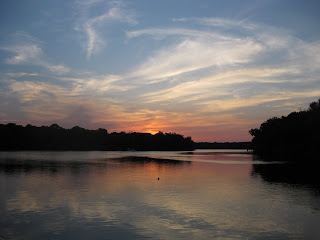
On May 13, 2010 Harry and Leslie completed their Great Loop Cruise aboard their motor vessel “Somewhere”, crossing their wake at the entrance to St. James Marina near
 traveling up the Tennessee River to Chattanooga at the height of the fall colors
traveling up the Tennessee River to Chattanooga at the height of the fall colors and leaving the ICW in Florida to travel up the St. Johns River to Blue Springs State Park.
and leaving the ICW in Florida to travel up the St. Johns River to Blue Springs State Park. Each of these side trips added to the enjoyment of our entire trip. Along the way we met so many wonderful people, some will remain friends for many years to come. We will always remember those who generously shared their favorite places and provided “local knowledge” which was invaluable on a trip of this nature. Their kindness will not be forgotten. It is on a trip like this that one can reflect on the true goodness of people. It was a privilege to experience the natural beauty of our great country and, of course, that of our neighbor to the north. As our trip drew to a close we spent more time reflecting on our adventure and the places we had been. A few of our favorite memories are leaving Staten Island and seeing the majesty of New York City ahead
Each of these side trips added to the enjoyment of our entire trip. Along the way we met so many wonderful people, some will remain friends for many years to come. We will always remember those who generously shared their favorite places and provided “local knowledge” which was invaluable on a trip of this nature. Their kindness will not be forgotten. It is on a trip like this that one can reflect on the true goodness of people. It was a privilege to experience the natural beauty of our great country and, of course, that of our neighbor to the north. As our trip drew to a close we spent more time reflecting on our adventure and the places we had been. A few of our favorite memories are leaving Staten Island and seeing the majesty of New York City ahead or crossing the expanse of Lake Michigan in the fog and seeing the Chicago skyline looming on the horizon.
or crossing the expanse of Lake Michigan in the fog and seeing the Chicago skyline looming on the horizon.  The interesting locks, especially the Big Chute Railway,
The interesting locks, especially the Big Chute Railway, the Peterborough Lift Lock
the Peterborough Lift Lock and the Wilson Lock on the Tennessee River with its 93’ lift to name a few.
and the Wilson Lock on the Tennessee River with its 93’ lift to name a few. Winding our way through the
Winding our way through the  or cruising the
or cruising the  We will always remember the beautiful Hudson River with West Point standing guard majestically
We will always remember the beautiful Hudson River with West Point standing guard majestically

 and the fabulous adventures of the Rideau and
and the fabulous adventures of the Rideau and 

 and dive the Marine Reserves of John Pennecamp Coral Reef State Park
and dive the Marine Reserves of John Pennecamp Coral Reef State Park  and the unforgettable sight of the Space Shuttle Discovery hurtling into space.
and the unforgettable sight of the Space Shuttle Discovery hurtling into space. Finally, we will remember the more familiar but no less enjoyable stops of
Finally, we will remember the more familiar but no less enjoyable stops of  and Hilton Head.
and Hilton Head. There are so many more! This was an adventure which we will savor for many years. Those who have said that it is not the destination that is important, it is the journey must have been thinking of
There are so many more! This was an adventure which we will savor for many years. Those who have said that it is not the destination that is important, it is the journey must have been thinking of










































